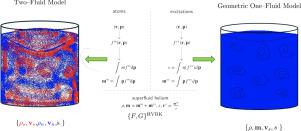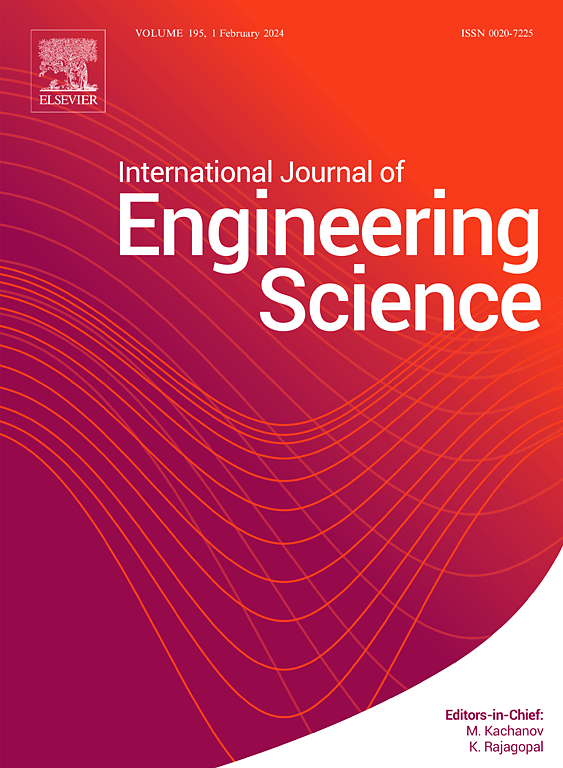A geometric one-fluid model of superfluid helium-4
IF 5.7
1区 工程技术
Q1 ENGINEERING, MULTIDISCIPLINARY
International Journal of Engineering Science
Pub Date : 2025-09-11
DOI:10.1016/j.ijengsci.2025.104377
引用次数: 0
Abstract
A standard description of superfluid helium-4 is based on the concept of two components (superfluid and normal), which leads to the so called two-fluid models. However, as there are no two kinds of atoms in helium-4, the two components cannot be separated. Superfluid helium-4 is not a mixture of two components, being rather a single fluid with two motions. Here, we present a geometric one-fluid model of superfluid helium-4, which is based on the Hamiltonian formulation of fluid mechanics. The model is derived from the kinetic theory of excitations (treated as an ideal Bose gas under the temperature ) and average particle motions. It can be simplified to the Hall–Vinen–Bekharevich–Khalatnikov (HVBK) two-fluid model, where it removes one fitting parameter from the HVBK model, but it also gives extra terms beyond the HVBK model. Actually, we show that the two-fluid models are problematic in case of higher counter-flow velocities, where the usual splitting of total momentum to the superfluid and normal component becomes impossible. Finally, we show how vortex line density may be added to the state variables. The one-fluid model can be seen as a generalization of the two-fluid models that is geometrically consistent, fully compressible, with non-zero superfluid vorticity, and compatible with classical experiments.

超流体氦-4的几何单流体模型
超流体氦-4的标准描述是基于两组分(超流体和正常)的概念,这导致了所谓的双流体模型。然而,由于氦-4中没有两种原子,这两种成分不能分开。超流体氦-4不是两种成分的混合物,而是一种具有两种运动的单一流体。本文提出了一个基于流体力学哈密顿公式的超流体氦-4的几何单流体模型。该模型由激发态(在温度1.3K下作为理想玻色气体)和平均粒子运动的动力学理论推导而来。它可以简化为Hall-Vinen-Bekharevich-Khalatnikov (HVBK)双流体模型,其中它从HVBK模型中删除了一个拟合参数,但它也给出了超出HVBK模型的额外项。实际上,我们表明,双流体模型在较高逆流速度的情况下是有问题的,在这种情况下,通常的总动量向超流体和法向分量的分裂变得不可能。最后,我们展示了如何将涡线密度添加到状态变量中。单流体模型可以看作是双流体模型的推广,它几何上一致,完全可压缩,具有非零超流体涡量,并且与经典实验相兼容。
本文章由计算机程序翻译,如有差异,请以英文原文为准。
求助全文
约1分钟内获得全文
求助全文
来源期刊

International Journal of Engineering Science
工程技术-工程:综合
CiteScore
11.80
自引率
16.70%
发文量
86
审稿时长
45 days
期刊介绍:
The International Journal of Engineering Science is not limited to a specific aspect of science and engineering but is instead devoted to a wide range of subfields in the engineering sciences. While it encourages a broad spectrum of contribution in the engineering sciences, its core interest lies in issues concerning material modeling and response. Articles of interdisciplinary nature are particularly welcome.
The primary goal of the new editors is to maintain high quality of publications. There will be a commitment to expediting the time taken for the publication of the papers. The articles that are sent for reviews will have names of the authors deleted with a view towards enhancing the objectivity and fairness of the review process.
Articles that are devoted to the purely mathematical aspects without a discussion of the physical implications of the results or the consideration of specific examples are discouraged. Articles concerning material science should not be limited merely to a description and recording of observations but should contain theoretical or quantitative discussion of the results.
 求助内容:
求助内容: 应助结果提醒方式:
应助结果提醒方式:


